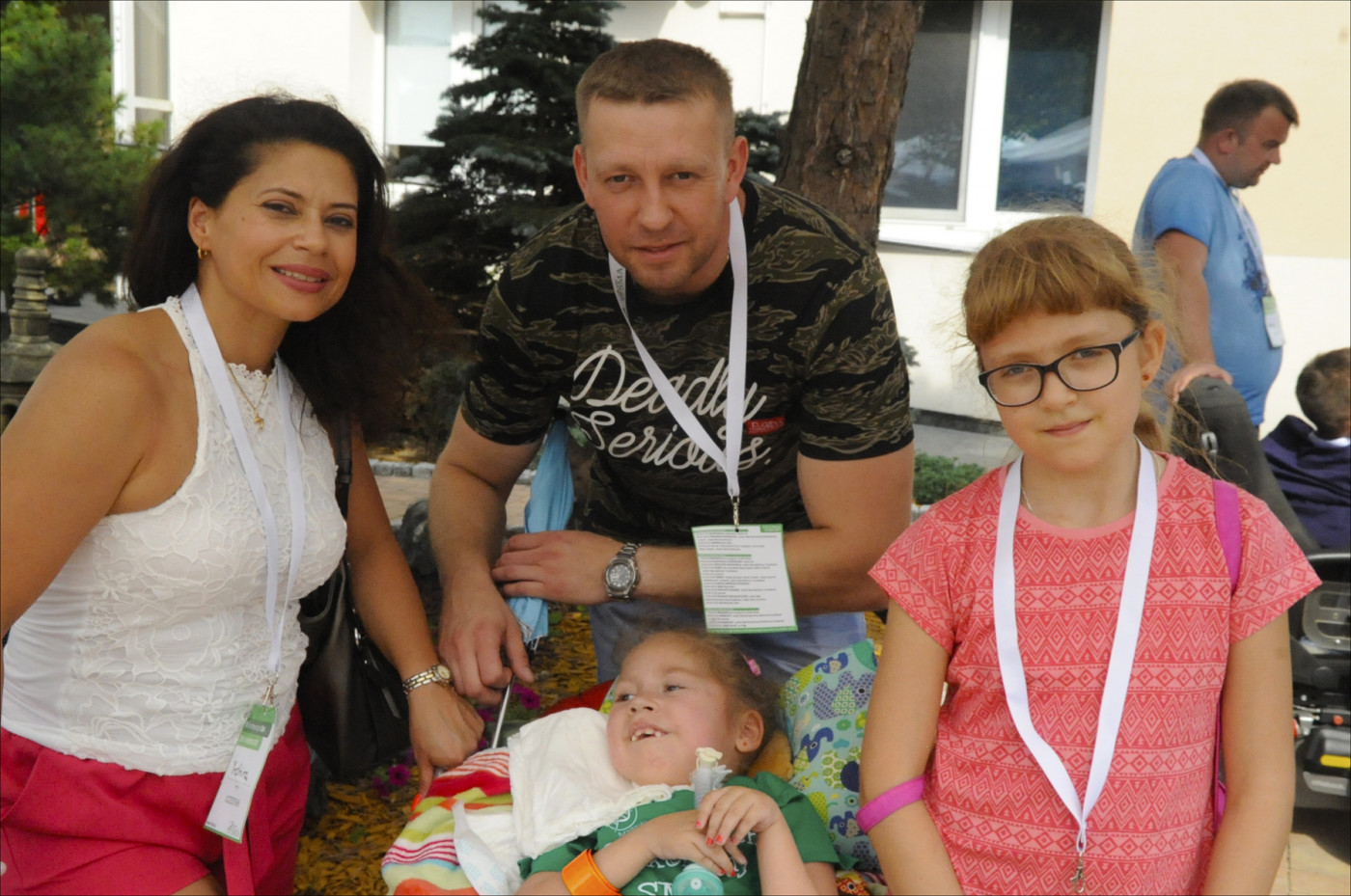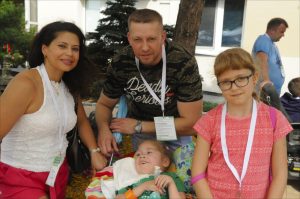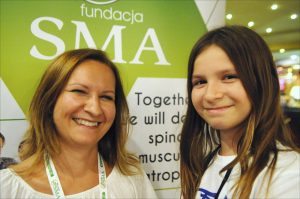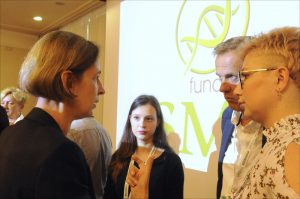With Spinraza Unavailable at Home, Polish SMA Patients Seek Therapy However They Can
Written by |

Yndhira Ramírez and Lukasz Szczepara, with their daughters Abril, 11, and Gabriela, 6. (Photo by Larry Luxner)
Lukasz Szczepara showed up to a recent spinal muscular atrophy (SMA) conference in Poland wearing a camouflage T-shirt emblazoned with the words “Deadly Serious.” It was no coincidence.
Szczepara and his Venezuelan wife, Yndhira Ramírez, have made it their life’s mission to ensure one thing: the health of their younger daughter, Gabriela, who has SMA type 1. Among other things, this means the entire family must travel by ambulance from their home in Zawiercie, Poland, to Belgium and back three times a year so the 6-year-old can receive Spinraza (nusinersen) — possibly the therapy that’s keeping her alive.
“She’s getting injected once every four months,” Szczepara said. “Since we started, she’s stronger, she can swallow and she can lift her arms. She can also push and pull her legs. Before, she couldn’t do any of those things.”
Added Ramírez: “Maybe soon she’ll be able to sit by herself.”
The couple, which also has a healthy 11-year-old, Abril, was among 400 people attending last month’s 6th Polish SMA Conference in Warsaw. The event, which SMA News Today covered, was hosted by the Polish nonprofit group Fundacja SMA.
Dorota Raczek, organizer of that meeting, has an 11-year-old daughter, Emilka, with SMA type 3. This is the sixth year Raczek has participated in the gathering.
“The first conference was very hard for us,” she said. “In my city, Rybnik, nobody has SMA, so until I came to Warsaw for that first meeting, we never saw another person with SMA. It was emotionally very hard for us. If you look at my daughter, you wouldn’t even know she’s ill.”
For now, Emilka is getting only physiotherapy — no medications of any kind. But her prognosis without Spinraza is not good.
Join the SMA forums and be part of the conversation about Spinraza.
“If she doesn’t get nusinersen, she will stop walking,” Raczek said. “Many girls, when they reach 11, 12 or 13, stop walking because this is connected to hormones. We’re still waiting in Poland for reimbursement because it’s a very expensive medicine. But if by the end of the year we don’t get it, we’re going to Germany where we have family and friends.”
Getting into Biogen’s EAP
Kacper Rucinski, president of Fundacja SMA, said about 500 people throughout the EU have now been treated with Spinraza. At present, 22 out of the EU’s 28 member states provide reimbursements for the injectable therapy, which carries a U.S. retail price of $750,000 for the first year of treatment and $375,000 every year thereafter.
In August, a committee of the U.K.’s independent National Institute of Health and Care Excellence (NICE) recommended against reimbursement of Spinraza to treat SMA in England, Wales, and Northern Ireland because of the therapy’s “extremely high cost.”
Ramírez said that for the first months after Gabriela’s birth, she and her husband didn’t really notice anything was wrong.
“But when we took her for a normal consultation at four months, our pediatrician noticed she couldn’t lift her head. So she sent Gabriela to a physiotherapist,” Ramírez said. “We did so many exercises and she didn’t get better. Finally, a neurologist saw her and told us she had SMA. I knew absolutely nothing about the disease. It was like a bucket of cold water.”
Eventually, Szczepara and Ramírez sought help from Rucinski, who got in touch with Laurent Servais, a physician with Belgium’s CHC de la Citadelle Hospital in Liege. The family flew to Belgium so Servais could examine Gabriela.
“It was so difficult to get into the trials,” said Ramírez, who’s lived in Poland for 11 years. “At the beginning, there were so many criteria. Either you were too young, too old, too heavy or too thin. They were accepting only babies 2 to 7 months old.”
After an extensive consultation, he determined that Spinraza might help her, and accepted the girl into Biogen’s Expanded Access Program (EAP) — a temporary “compassionate use” arrangement to enable access to Spinraza by a limited number of patients who need it.
She became one of 27 Polish patients benefiting from Biogen’s EAP, which originally began in France, according to Fundacja SMA. Many of those patients were transferred to Belgium when the French program ended. Another 28 are now receiving treatment as part of the EAP in Poland.
In addition, an unknown number of Polish families of SMA patients who couldn’t qualify for such programs have simply emigrated to Germany and other countries whose national health system covers the cost of Spinraza.
Big expenses even if Spinraza is free
Simply because Gabriela’s parents don’t pay for the therapy doesn’t mean treatment is cheap.
“It costs €1,400 (about $1,625) just for the hospitalization to get the injection, and what’s sad is that there are people who can’t travel … to make the trip to Belgium or France,” Ramírez said.
There’s also the 14-hour ambulance trip from Zawiercie to Liege. That, along with hotels, food and other expenses, comes to about €2,500 (roughly $2,900) per round-trip journey. The family has made that road trip five times since the initial consultation in August 2017, when they traveled by plane — which Ramírez said was way too stressful.
Gabriela’s condition also requires a nurse to visit the family’s home three times a week for nine hours each time. The nurse bathes her, cleans the breathing tubes, and helps with other light tasks at a cost of €500 (about $580) per month. Additional monthly expenses, including spare parts for Gabriela’s respirator, add another €1,000 ($1,160).
“We cannot leave her with anyone else, not even with my mother-in-law, because she doesn’t have any idea how to care for Gabriela. She can’t do anything by herself. She can’t turn herself or pick something from the floor if it falls,” Ramírez said. “But intellectually she’s fine, and a teacher comes to our house. We don’t have to pay for that.”
In March, Gabriela contracted pneumonia and her parents couldn’t keep her at home; nor could the local hospital in Zawiercie care for her. The girl spent three weeks recovering at a hospital in Katowice, 40 kilometers away, and is now doing much better.
“She’s already asking us, ‘When am I going to walk?’ Sometimes she talks to herself, saying ‘now I’m riding a bicycle, now I’m going with my friends.’ She uses her imagination. She also asks me difficult questions, and she understands that she’s sick,” Ramírez said. “She’s a happy girl, considering her disease.”
Twins with SMA
Patryk Marczuk is the scientific information coordinator at Fundacja SMA.
An information specialist who works in the purchasing department of a large company, Marczuk is also the father of 6-year-old identical twins — Gabriela and Patrycja — both of whom have SMA type 3.
Even before the diagnosis, which came when the twins were 2.5 years old, Marczuk and his wife, Anna, a financial auditor, knew something was wrong.
“Like with most SMA type 3 kids, they started walking but didn’t progress. Their walk was wobbly, and they couldn’t climb stairs or run. So we knew it wasn’t normal,” he said. “But nobody knew what it was, and it took one year for the neurologists in Poland to diagnose my kids.”
Genetic blood tests confirmed the bad news.
“I Googled what the hell was this SMA. When I found out, it was like getting a heart attack,” he said. “The doctor told me it’s serious and there is no cure, but not to worry, there would be one day.”
In the meantime, Marczuk said, “our daughters don’t remember walking. For them, it’s something normal. This is how they’ve always been. I’m amazed they don’t envy other kids.”
A fortunate phone call
Marczuk and other parents of SMA children got some hopeful news in August 2017, when Biogen filed an application with the Polish government to reimburse patients for Spinraza.
“An agency of the Polish Ministry of Health issued a positive recommendation on Spinraza, with no limitations for age or type of SMA. Now the ministry has to take a decision. They often go with the recommendation, but they don’t have to,” Marczuk said.
But he added, “the decision should have been made already, and it’s still not there.”
At present, 518 patients appear on the Polish SMA registry, though experts say there are probably 700 cases in the country, based on the disease’s natural history. In fact, it was an unexpected call from the registry administrator that kept Marczuk and his family from leaving Poland out of desperation.
“I was halfway packing my suitcase for Germany when she told us we had been selected for Roche’s SUNFISH trial,” he said. “This was the happiest phone call of my life.” The placebo-controlled Phase 2/3 trial (NCT02908685), which opened in October 2016, offers the possibility of 24 months of treatment and continuing in an open-label extension study.
Gabriela and Patrycja began participating in this trial of risdiplam (formerly RG7916) — an oral SMN2 splicing modifier taken once a day — in July. At present, 33 Polish children are in SUNFISH.
Marczuk won’t know for sure until July 2019 whether his daughters received the strawberry-flavored liquid or just a placebo.
“Risdiplam is a splicing modifier whose mechanism of action is similar to Spinraza,” he said. “Maybe if all goes well, this drug might be the competition to Spinraza in the future.”










